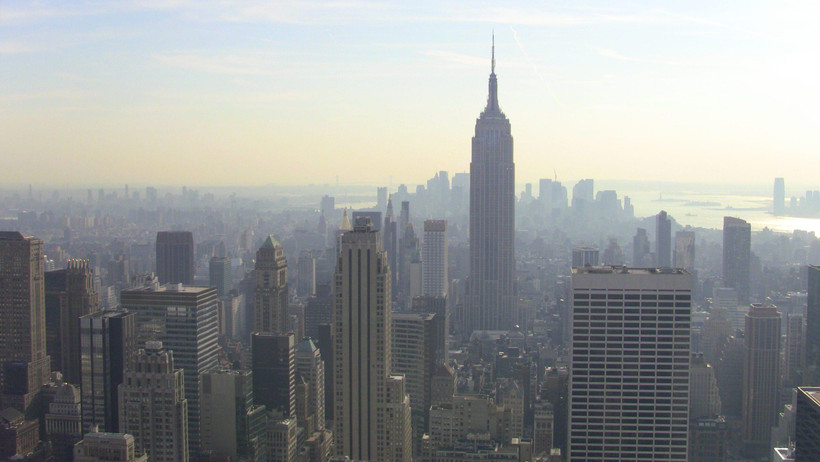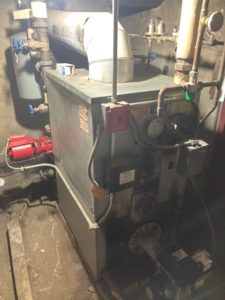New York’s biggest climate problem—and opportunity
Buildings may be New York’s top source of emissions. The state should follow the city’s lead in cleaning them up.

This article is published in our Perspectives section, featuring analyses and views by New Yorkers uniquely qualified to weigh in on high-stakes political debates. Pete Sikora is director of climate and inequality campaigns at New York Communities for Change.
I direct climate campaigns for an advocacy group, yet right in my basement, there it sits, huffing and puffing away: an oil boiler. It’s our apartment building’s resident evil. And it’s entirely typical in New York state, where heating, cooling and electricity in buildings is overwhelmingly dependent on fossil fuels.
Climate-heating pollution generated from energy use in buildings is either the top or second highest source of the state’s emissions, depending on the measurement used. Cleaning up buildings that are dependent on fossil fuels is an enormous challenge. It’s also an immense opportunity to create massive numbers of jobs in design, renovation and construction through energy efficiency upgrades.
New York City is pointing a path forward with its landmark new law, Local Law 97 of 2019. It’s the first law passed by any city in the world to set specific limits on climate-heating pollution from large, existing buildings, which, even though they’re just 5% of the city’s buildings, generate about 40% of the city’s total greenhouse gas emissions.
If Cuomo is impeached or forced to resign, real estate would lose its most powerful ally in Albany. But the industry’s lobbyists won’t resign with him, and we’ll still need a major grassroots campaign to muscle through a Green New Deal for buildings.
The city’s law will make owners of large properties upgrade their polluting buildings to high energy efficiency this decade, which in turn will generate tens of thousands of jobs in design, renovation and construction. The building modernization will also reduce other noxious air pollution generated by burning gas and oil that causes asthma and worsens respiratory illnesses like COVID-19.
In aggregate, buildings covered by the law are expected to slash their pollution by 40% by 2030 and over 80% by 2050. (Per-square-foot pollution limits are set by building type, so reductions will vary between dwellings). The law’s first requirements to cut emissions take hold in 2024.
Or rather, the law’s pollution-cutting limits will take hold—unless Governor Cuomo and the real estate industry gut the law through nefarious language they’re attempting to shoehorn into the state budget, due for enactment on April 1st.
New York City is Leading...
I live in a 4 unit co-op in Cobble Hill, Brooklyn. The building is smaller than 25,000 square feet, so the city has not (yet) mandated it to clean up. My parent’s building in Washington Heights, like many across the city, is six stories tall. It’s a fine-looking building, but poorly insulated and drafty. Its large boiler is gas-fired.
Buildings can make many low-cost or even no-cost improvements to slash energy waste and immediately cut utility bills. Easy steps include replacing incandescent light bulbs with LEDs, insulating heating pipes, putting in lower-flow and aerating shower heads, covering or removing window A/C units in the winter, and tuning and operating boilers correctly. The building is one of about 50,000 covered by the law, which collectively generate over half of the pollution derived from energy use in the city’s buildings. They range in size from my childhood home right up to an enormous skyscraper like One World Trade Center.
 The author's building's fossil fuel boiler.
The author's building's fossil fuel boiler.Yet for most buildings, simple low-cost fixes won’t be enough. By the time that the law’s tougher requirements take hold in 2030 and later, more labor- and capital-intensive upgrades will be necessary. Depending on the building, those may include better insulation, HVAC systems, green roofs, and new energy efficient windows.
Over time, buildings will also need to ditch fossil fuel boilers entirely in favor of a technology called a heat pump. Heat pumps operate on the same principle as the coils in the back of your refrigerator. They move a liquid refrigerant through a loop to move heat out of buildings in the summer and into them in the winter. Like refrigerators, heat pumps require far less energy than fossil fuel boilers.
Owners of large buildings are already hiring design firms to figure out the most cost-efficient upgrades to cut energy waste. Compliance across the city’s 50,000 large buildings will be a major undertaking. Local Law 97’s requirements will mobilize billions of dollars in capital investment and create tens of thousands of new jobs this decade, including good, union jobs hiring from low-income brackets and communities of color.
We can’t declare victory yet. The next Mayor and Council will need to fend off the real estate lobby, which bitterly opposed the law’s passage. The landlord lobby will doubtless attempt to undermine its implementation. Future city leadership can’t allow that—and voters should be wary of any candidate who wavers on Local Law 97.
Besides implementing the new law, the city should take the next two logical steps: a ban on gas in new construction and gut renovations and equitable requirements to require small buildings to clean up in a cost-conscious manner.
There’s much to be done, but the city is moving forward. The state under Governor Cuomo, has an entirely different record.
...And New York State Must Follow
The real estate lobby wants to either gut Local Law 97 or weaken it. Governor Cuomo, who has received millions in campaign contributions from the industry, is happy to oblige. In January—before his current massive scandals erupted—Cuomo attached legislative language to his proposed state budget to override the city’s climate law and effectively eliminate requirements to reduce building energy use.
Instead of being required to upgrade their buildings, owners would be able to buy Renewable Energy Credits (RECs) to evade the law’s requirements. RECs are certificates of energy produced by a renewable energy project.
Buying a REC doesn’t mean the electricity you use is clean. Rather, it means that an entity that produced the credit gets paid for clean electricity that it produced. If you’re a developer who owns a large, polluting building, purchasing RECs to avoid cleaning up your building is akin to a feudal lord from the dark ages buying an indulgence from the Catholic Church.
If the Governor succeeds at putting through the landlord lobby proposal, it will allow building owners to buy their way out of upgrading their buildings with cheap, nearly unlimited RECs. As State Senator Liz Krueger put it in response: “This would create a loophole in the law that you could drive a big, polluting, diesel truck through.”
The Governor’s proposal would cost the city the many jobs and huge pollution reductions that the law is currently on track to generate. It’s vital the Legislature defeat his proposal. You might think, given how a spate of recent scandals have weakened the governor, that would be easy. But you’d be underestimating the power of real estate interests in Albany.
After many organizations and activists pressed them, the Senate and Assembly explicitly rejected Cuomo’s proposal in their “one house” budget resolutions. The Legislature deserves credit for standing up for New York City’s law—and its leaders must hold firm this week as Cuomo presses them in the three-way negotiation to reach a final deal to pass this year’s state budget.
A Green New Deal for New York’s buildings
Cuomo’s proposal to gut Local Law 97 is just the latest in his decade-long record of unwillingness to impose on the real estate industry and reduce pollution from buildings. He has refused to set requirements to clean up polluting buildings, instead relying on incremental improvements to the building code. All the glaciers will be fully melted and New York’s coast under water by the time that approach yields results at the scale needed to drive down greenhouse gas pollution.
The state has also vastly underfunded programs to upgrade buildings. And to add insult to injury, what little funds it has allocated to subsidize energy efficiency are raised through a charge on utility bills—a regressive form of taxation.
New York state should take the Local Law 97 model requirements for large buildings and expand them statewide. It should also set requirements on smaller buildings to eliminate fossil fuel use over time. For example, it could immediately prevent any new construction or gut renovations from hooking up to gas, which would immediately lead to widespread adoption of high energy efficiency and heat pumps in new developments.
The state could and should defray costs for affordable housing; upgrade all public, social and supportive housing; and build new, non-polluting housing. It could help close society’s gaping inequalities by raising taxes on the rich to pay for these improvements at large-scale.
Yet the state has failed to act on this issue because it is in thrall to real estate. Before fighting Local Law 97 tooth-and-nail, the landlord lobby opposed a weaker version of requirements that Mayor Bloomberg had proposed in 2010. Now they complain that Local Law 97, passed in 2019, applies too quickly (even though it allows owners five years of run-up time to its requirements)
If Cuomo is impeached or forced to resign, real estate would lose its most powerful ally in Albany. But the industry’s lobbyists won’t resign with him, and we’ll still need a major grassroots campaign to muscle through a Green New Deal for buildings.
As with Local Law 97, statewide requirements would create good, union jobs hiring from low-income and communities of color. It’s time for New York’s climate and environmental groups to join with community organizations to drive this agenda.
This week, the legislature must turn back Cuomo’s attempt to gut Local Law 97. Next, we’ll need leadership that actually leads New York’s climate policies into the future—and that does not ignore the boilers lurking in our basements.



